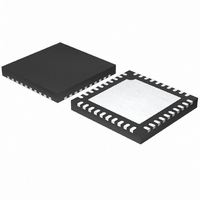MAX8760ETL+T Maxim Integrated Products, MAX8760ETL+T Datasheet - Page 33

MAX8760ETL+T
Manufacturer Part Number
MAX8760ETL+T
Description
IC CNTRLR QUICK PWM 40-TQFN
Manufacturer
Maxim Integrated Products
Datasheet
1.MAX8760ETL.pdf
(39 pages)
Specifications of MAX8760ETL+T
Applications
Controller, 6-bit VID AMD Mobile Turion™
Voltage - Input
4 ~ 28 V
Number Of Outputs
2
Voltage - Output
0.38 ~ 1.55 V
Operating Temperature
0°C ~ 85°C
Mounting Type
Surface Mount
Package / Case
40-TQFN Exposed Pad
Output Voltage
0.375 V to 1.55 V
Output Current
4000 mA
Mounting Style
SMD/SMT
Switching Frequency
550 KHz
Maximum Operating Temperature
+ 100 C
Minimum Operating Temperature
- 40 C
Synchronous Pin
No
Topology
Buck
Lead Free Status / RoHS Status
Lead free / RoHS Compliant
For Quick-PWM controllers, stability is determined by
the value of the ESR zero relative to the switching fre-
quency. The boundary of instability is given by the fol-
lowing equation:
where:
and:
where C
total equivalent-series resistance, R
current-sense resistance, A
gain, and R
between the output capacitors and sense resistors.
For a standard 300kHz application, the ESR zero fre-
quency must be well below 95kHz, preferably below
50kHz. Tantalum, Sanyo POSCAP, and Panasonic SP
capacitors in widespread use at the time of publication
have typical ESR-zero frequencies below 50kHz. For
example, the ESR needed to support a 30mV
in a 40A design is 30mV/(40A x 0.3) = 2.5mΩ. Four
330µF/2.5V Panasonic SP (type XR) capacitors in paral-
lel provide 2.5mΩ (max) ESR. Their typical combined
ESR results in a zero at 40kHz.
Ceramic capacitors have a high ESR-zero frequency,
but applications with significant voltage positioning can
take advantage of their size and low ESR. Do not put
high-value ceramic capacitors directly across the
output without verifying that the circuit contains enough
voltage positioning and series PC board resistance to
ensure stability. When only using ceramic output
capacitors, output overshoot (V
mines the minimum output capacitance requirement.
Their relatively low capacitance value can cause output
overshoot when stepping from full-load to no-load con-
ditions, unless a small inductor value is used (high
switching frequency) to minimize the energy transferred
from inductor to capacitor during load-step recovery.
The efficiency penalty for operating at 550kHz is about
5% when compared to the 300kHz circuit, primarily due
to the high-side MOSFET switching losses.
Output Capacitor Stability Considerations
OUT
R
EFF
is the total output capacitance, R
PCB
=
Dual-Phase, Quick-PWM Controller for AMD
Mobile Turion 64 CPU Core Power Supplies
R
f
ESR
______________________________________________________________________________________
is the parasitic board resistance
ESR
f
=
ESR
+
2π
A
≤
VPS SENSE
VPS
R
EFF OUT
f
SW
R
π
1
is the voltage-positioning
C
SOAR
+
) typically deter-
R
PCB
SENSE
ESR
P-P
is the
ripple
is the
Unstable operation manifests itself in two related but
distinctly different ways: double-pulsing and feedback
loop instability. Double-pulsing occurs due to noise on
the output or because the ESR is so low that there is
not enough voltage ramp in the output voltage signal.
This “fools” the error comparator into triggering a new
cycle immediately after the minimum off-time period
has expired. Double-pulsing is more annoying than
harmful, resulting in nothing worse than increased out-
put ripple. However, it can indicate the possible pres-
ence of loop instability due to insufficient ESR. Loop
instability can result in oscillations at the output after
line or load steps. Such perturbations are usually
damped, but can cause the output voltage to rise
above or fall below the tolerance limits.
The easiest method for checking stability is to apply a
very fast zero-to-max load transient and carefully
observe the output voltage ripple envelope for over-
shoot and ringing. It can help to simultaneously monitor
the inductor current with an AC current probe. Do not
allow more than one cycle of ringing after the initial
step-response under/overshoot.
The input capacitor must meet the ripple current
requirement (I
The multiphase Quick-PWM controllers operate out-of-
phase, while the Quick-PWM slave controllers provide
selectable out-of-phase or in-phase on-time triggering.
Out-of-phase operation reduces the RMS input current
by dividing the input current between several stag-
gered stages. For duty cycles less than 100%/η
per phase, the I
by the following equation:
where η
ing regulators. The worst-case RMS current requirement
occurs when operating with V
point, the above equation simplifies to:
For most applications, nontantalum chemistries (ceramic,
aluminum, or OS-CON™) are preferred due to their resis-
tance to inrush surge currents typical of systems with a
mechanical switch or connector in series with the input. If
the Quick-PWM controller is operated as the second
stage of a two-stage power-conversion system, tantalum
input capacitors are acceptable. In either configuration,
choose an input capacitor that exhibits less than 10°C
temperature rise at the RMS input current for optimal cir-
OS-CON is a trademark of Sanyo.
I
RMS
=
OUTPH
⎛
⎜
⎝
η
OUTPH IN
I
LOAD
RMS
I
RMS
is the total number of out-of-phase switch-
V
RMS
) imposed by the switching currents.
= 0.5 x I
⎞
⎟
⎠
requirements can be determined
Input Capacitor Selection
η
OUTPH OUT
LOAD
IN
V
= 2η
/η
OUTPH
(
V
OUTPH
IN
−
.
η
V
OUTPH OUT
OUT
. At this
V
OUTPH
33
)










